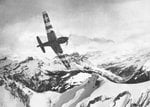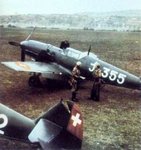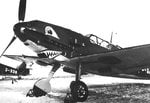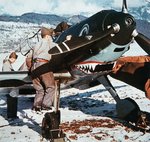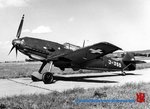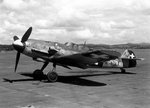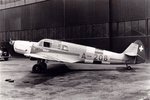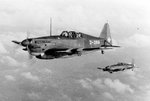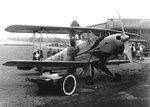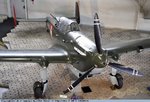The history of the Swiss Air Force began in 1914 with the establishment of an ad hoc force consisting of a handful of men in outdated and largely civilian aircraft. It was only in the 1930s that an effective air force was established at great cost, capable of inflicting several embarrassing defeats on the Nazi Luftwaffe in the course of an initially vigorous defence of neutral Swiss airspace. The Swiss Air Force as an autonomous military service was created in October 1936. After World War II it was renamed the Swiss Air Force and Anti-Aircraft Command (Schweizerische Flugwaffe Kommando der Flieger und Fliegerabwehrtruppen) and in 1996 became a separate service independent from the Army, under its present name Schweizer Luftwaffe. The mission of the Swiss Air Force historically has been to support ground troops (erdkampf) in repelling invasions of neutral Swiss territory, with a secondary mission of defending the sovereignty of Swiss airspace. During World War II this doctrine was severely tested when Switzerland was literally caught in the middle of an air war and subjected to both attacks and intrusions by aircraft of all combatants. Its inability to prevent such violations of its neutrality led for a period to a complete cessation of air intercepts, followed by a practice of coercing small numbers of intruders to submit to internment.
The Swiss Air Force mobilized on 28 August 1939, three days before Germany attacked Poland and initiated World War II, with 96 fighter and 121 observation aircraft; by some accounts the country possessed only eight antiaircraft searchlights. Of the 21 units of the Swiss Air Force, only three were judged combat-ready and five were not yet equipped with aircraft. The Air Force relied on 40 single-seat interceptors for first-line air defense.This deficiency was addressed by procuring further German Bf 109, Italian Macchi MC.202, and French Morane D-3800 fighters. In 1942, the Swiss-built F+W C-36 multipurpose aircraft was introduced into service, and in 1943, Switzerland opened its own aircraft factory, Flugzeugwerk Emmen. Caverns were built in which to shelter aircraft and maintenance personnel from air attack, for example in Alpnach, Meiringen and Turtmann. In 1942-43, an air gunnery range at Ebenfluh-Axalp was opened for training. The Surveillance Squadron (Überwachungsgeschwader) was formed in 1941 and made combat-ready in 1943. A night fighter squadron was formed for evaluation purposes in 1944 and disbanded in 1950.
During the first months of the war, airmen and anti-aircraft soldiers saw only sporadic combat; it was on 10 May 1940, when Germany commenced the drive into the west, that the Swiss army as a whole was mobilized a second time. At the onset of the campaign, German military aircraft first violated Swiss airspace. The first serious combat involving the Swiss Air Force began in June 1940. In six days of aerial battles, eleven German aircraft were downed, with a loss of two Swiss aircraft and three airmen killed. Following these incidents, on 6 June, the chief of the Luftwaffe, Hermann Göring, protested the attacks, claiming that most of the German planes had been in French airspace and that the Luftwaffe had entered Swiss airspace only by mistake. Germany demanded financial compensation and an apology by the Swiss government. In a second, more pointed demand on 19 June, Germany stated that they viewed the air battles as a flagrant act of aggression, and if these interceptions continued, Switzerland would face sanctions and retaliation. The next day, General Henri Guisan ordered all Swiss units to stop engaging foreign aircraft, and on 1 July 1940, the Federal Council apologized for possible border violations by Swiss pilots, without admitting any had occurred. On 16 July, the German government declared that the events were settled. Engaging aircraft of the combatant nations was prohibited until October 1943, when strategic bombing of Bavaria and Austria by the Allies became an increasing likelihood.
In September 1944, the last Swiss airman died in combat, shot down by an American P-51 Mustang while escorting a crippled U.S. B-17 Flying Fortress to the Dübendorf airfiel During the entire war, 6,501 Allied and Axis aircraft violated Swiss airspace, 198 of which aircraft landed on Swiss soil and were interned, and 56 of which crashed. Swiss aircraft also intercepted U.S. aircraft who were off-course, or whose crews preferred asylum in Swiss internment camps over German or Italian POW camps; they were then forced to land on Swiss airstrips. When the bombers did not cooperate or even fired at the Swiss (who were using Axis-type interceptors), they were shot down.
The Swiss Air Force mobilized on 28 August 1939, three days before Germany attacked Poland and initiated World War II, with 96 fighter and 121 observation aircraft; by some accounts the country possessed only eight antiaircraft searchlights. Of the 21 units of the Swiss Air Force, only three were judged combat-ready and five were not yet equipped with aircraft. The Air Force relied on 40 single-seat interceptors for first-line air defense.This deficiency was addressed by procuring further German Bf 109, Italian Macchi MC.202, and French Morane D-3800 fighters. In 1942, the Swiss-built F+W C-36 multipurpose aircraft was introduced into service, and in 1943, Switzerland opened its own aircraft factory, Flugzeugwerk Emmen. Caverns were built in which to shelter aircraft and maintenance personnel from air attack, for example in Alpnach, Meiringen and Turtmann. In 1942-43, an air gunnery range at Ebenfluh-Axalp was opened for training. The Surveillance Squadron (Überwachungsgeschwader) was formed in 1941 and made combat-ready in 1943. A night fighter squadron was formed for evaluation purposes in 1944 and disbanded in 1950.
During the first months of the war, airmen and anti-aircraft soldiers saw only sporadic combat; it was on 10 May 1940, when Germany commenced the drive into the west, that the Swiss army as a whole was mobilized a second time. At the onset of the campaign, German military aircraft first violated Swiss airspace. The first serious combat involving the Swiss Air Force began in June 1940. In six days of aerial battles, eleven German aircraft were downed, with a loss of two Swiss aircraft and three airmen killed. Following these incidents, on 6 June, the chief of the Luftwaffe, Hermann Göring, protested the attacks, claiming that most of the German planes had been in French airspace and that the Luftwaffe had entered Swiss airspace only by mistake. Germany demanded financial compensation and an apology by the Swiss government. In a second, more pointed demand on 19 June, Germany stated that they viewed the air battles as a flagrant act of aggression, and if these interceptions continued, Switzerland would face sanctions and retaliation. The next day, General Henri Guisan ordered all Swiss units to stop engaging foreign aircraft, and on 1 July 1940, the Federal Council apologized for possible border violations by Swiss pilots, without admitting any had occurred. On 16 July, the German government declared that the events were settled. Engaging aircraft of the combatant nations was prohibited until October 1943, when strategic bombing of Bavaria and Austria by the Allies became an increasing likelihood.
In September 1944, the last Swiss airman died in combat, shot down by an American P-51 Mustang while escorting a crippled U.S. B-17 Flying Fortress to the Dübendorf airfiel During the entire war, 6,501 Allied and Axis aircraft violated Swiss airspace, 198 of which aircraft landed on Swiss soil and were interned, and 56 of which crashed. Swiss aircraft also intercepted U.S. aircraft who were off-course, or whose crews preferred asylum in Swiss internment camps over German or Italian POW camps; they were then forced to land on Swiss airstrips. When the bombers did not cooperate or even fired at the Swiss (who were using Axis-type interceptors), they were shot down.

